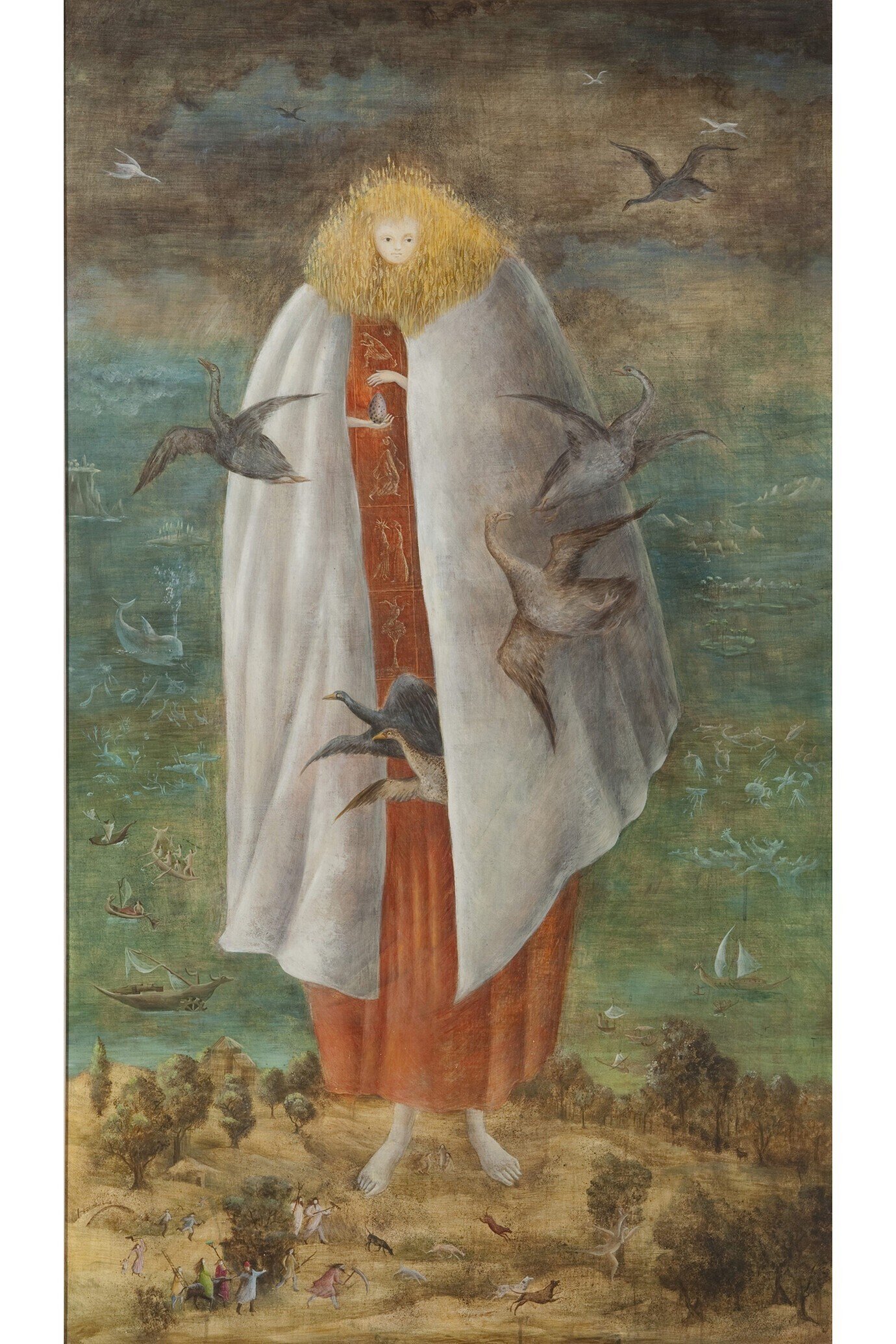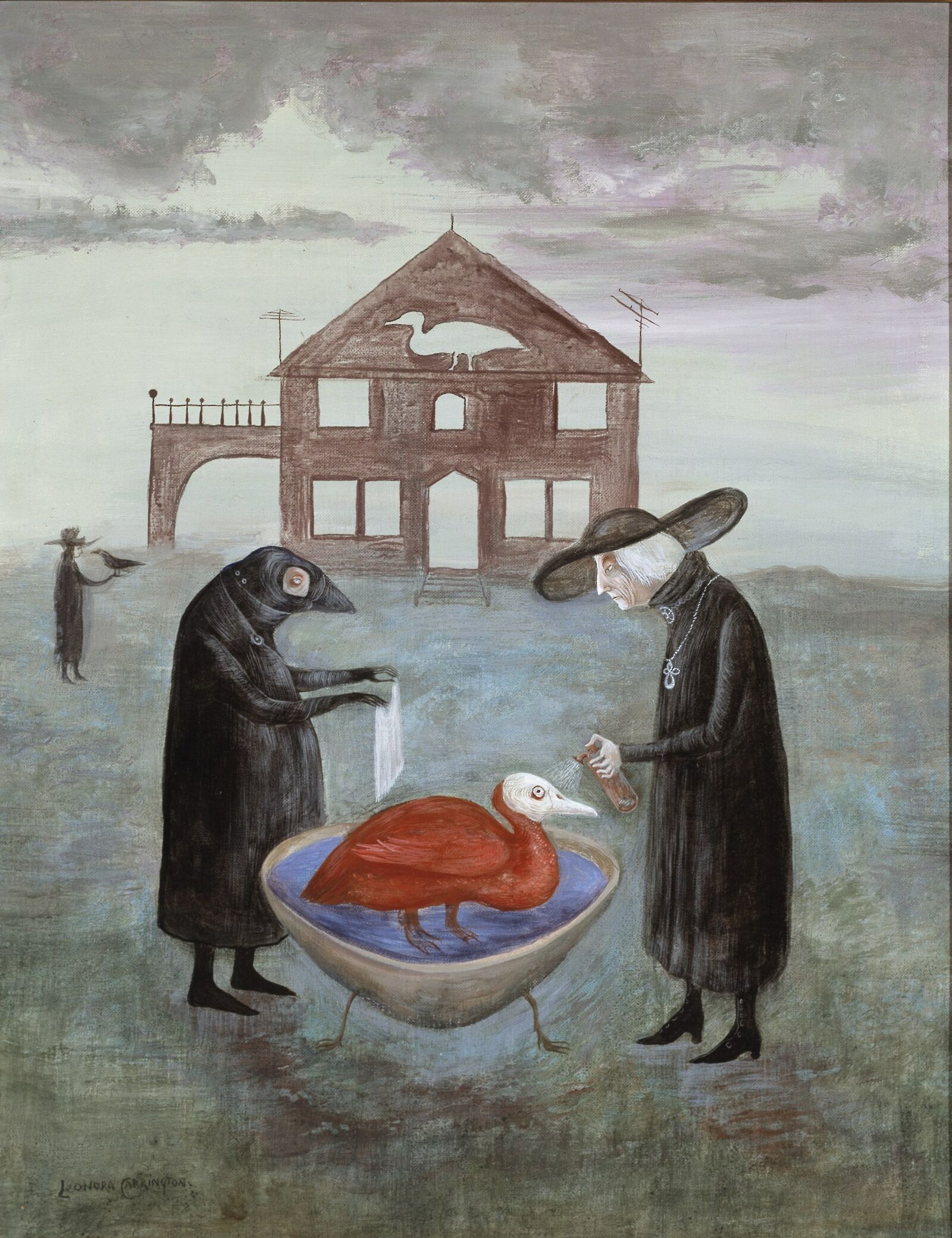Surrealist Meret Oppenheim in 5 Artworks
Exploring five works by female Surrealist Meret Oppenheim
Candy Bedworth 26 September 2024
Leonora Carrington (1917-2011) is considered one of the greatest but most neglected British Surrealists. Her life story is a fascinating one: she abandoned her family for a painter about 20 years her senior, she lived in Mexico and kept on painting until she was 90.

Carrington was the only daughter (among three brothers) of a Protestant textile magnate from Lancashire, England, and his Irish Catholic wife, Maurie. Although she said,
Our family weren’t cultured or intellectual – we were the good old bourgeoisie, after all.
Leonora Carrington, “Leonora and me“, The Guardian.
The family lived in a sinister mansion, an imposing edifice that often featured in her later paintings. Her parents were very different in character. Carrington’s workaholic father didn’t approve of Leonora, or Prim as the family called her, attending an art college. Her mother intervened, and eventually, she went to study Old Masters in Florence. If you look at her paintings you can see the love for gold, vermilion, and earth colors inspired by the Italian painting.

When she returned from Italy, her father wanted to marry her off. He launched her as a debutante and held a ball in her honor at the Ritz, and she was even presented to King George V!
Carrington despised the ball. She poured out her loathing of the debutante season into a surreal short story, The Debutante. And then a breakthrough moment arrived: in 1936, when Carrington was 19, the first Surrealist exhibition opened in London. As she recalled:
I fell in love with Max [Ernst]’s paintings before I fell in love with Max.
Leonora Carrington, “Leonora and me”, The Guardian.
It was like an epiphany.

She met him later in person at a dinner party and fell in love head over hills. They left London already together to settle in Paris, even though Ernst was married and he was still seeing his wife. Carrington plunged into Paris and art:
From Max I had my education: I learned about art and literature. He taught me everything.
Leonora Carrington, “Leonora and me”, The Guardian.
She met Picasso:
A typical Spaniard – he thought all women were in love with him, [but] well, I certainly wasn’t. Though I liked his art.
Leonora Carrington, “Leonora and me”, The Guardian.
And Salvador Dalí:
I met him by chance one day in André Breton’s shop. He certainly wasn’t extraordinary then: he looked like everyone else. It was only when he went to America that he started looking extraordinary.
Leonora Carrington, “Leonora and me”, The Guardian.

In 1938, right before the outbreak of World War II, Ernst left his wife, and the couple moved to Provance. It was a great time of artistic creativity, one painted the other, and Carrington also took up writing. Their idyll was shattered by the arrival of the Nazis, who considered Jewish Ernst an enemy alien and subsequently interned him. Sorrowful Carrington fled to Spain, where she had a mental breakdown and ended up in a psychiatric hospital in Santander.
Carrington’s father tried to get her out of the hospital and have her admitted to a sanatorium in South Africa instead. She didn’t want that, and while waiting for a boat with her father’s business contacts, she escaped and jumped into a taxi. “Take me to the Mexican embassy!” she shouted. It was the first place that came to her mind as she thought of her friend from Paris, Renato Leduc, who had been a Mexican diplomat. The only solution to her predicament he could think of was to marry her. So they did.

It was a marriage of convenience, and the issue got even more complicated. While the newlyweds were waiting in Lisbon for the boat to take them to the US, Ernst showed up in town to take the same boat. He was liberated from the camp and saw his new lover, the art collector Peggy Guggenheim. Carrington described this time as they waited together to go to New York as “very weird.” Especially since Guggenheim’s ex-husband, Ernst’s ex-wife, and a group of children were also traveling with them.

When Carrington arrived in New York, she dissolved her marriage. She moved to Mexico, which gave her a new inspiration boost. She did sculptures and paintings inspired by Aztec and Mayan myths. She also met a Hungarian photographer (and the darkroom manager for Robert Capa during the Spanish Civil War), Csizi (“Chiki”) Weisz who, a few years later, became her husband. It was a happy marriage; they spent over six decades together and had two sons, Gabriel and Pablo. In 1970, she helped to found the Women’s Liberation Movement in Mexico. She died at 94.
DailyArt Magazine needs your support. Every contribution, however big or small, is very valuable for our future. Thanks to it, we will be able to sustain and grow the Magazine. Thank you for your help!